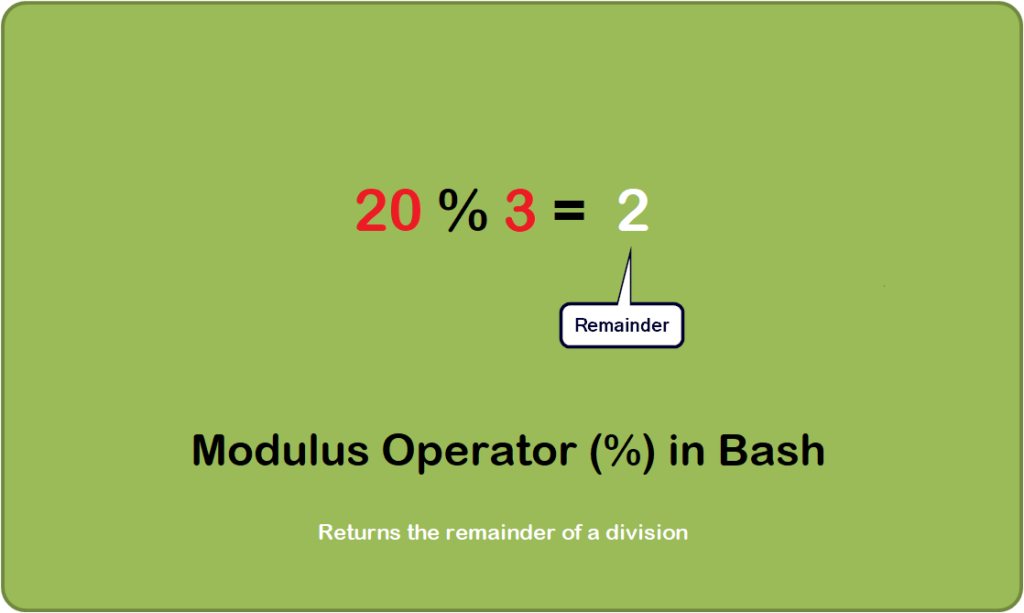QA (Quality Assurance) is a critical function in the software development process that ensures that products and services meet the highest standards of quality. As such, QA professionals play a vital role in software development organizations. Aspiring QA professionals must prepare themselves for the interview process to increase their chances of securing a job. In this article, we will discuss 20 common QA interview questions and the best answers to help you prepare for your next interview. You should also read: 20 Common Job Interview Questions And Answers What is your understanding of Quality Assurance? Answer: Quality Assurance is the…
Author: Rahul
In programming, modulus or remainder is the operation that returns the remainder of a division. In Bash, the modulus operator is represented by the % symbol. The modulus operator is commonly used in programming to check if a number is divisible by another number or to perform operations that require a cyclic pattern. In this article, we will explore how to use the modulus operator in Bash. Syntax: The syntax of the modulus operator in Bash is as follows:
1 | expr num1 % num2 |
Where num1 and num2 are the two numbers being operated on. The % symbol represents the modulus operator. Example 1:…
In programming, finding the remainder of a division is a common task. In Bash, the modulus operator “%” can be used to calculate the remainder of a division. However, the output of the modulus operator can be negative when dealing with negative numbers. Therefore, it is important to understand how to handle negative numbers when calculating the remainder in Bash. In this article, we will discuss how to calculate the remainder of a division in Bash and how to handle negative numbers. Method 1: Using the Modulus Operator (%) The Modulus operator, represented by the symbol %, is a binary…
Bash is a powerful command-line interface and scripting language that offers a wide range of mathematical operations, including division and remainder. Division and remainder are fundamental operations used in various programming and mathematical applications. This article will discuss how to perform division and remainder operations in Bash and their usage. Calculate Division in Bash The division is a mathematical operation that involves dividing one number by another. In Bash, division can be performed using the / operator. Here is an example:
1 2 3 | $ echo $(( 10 / 3 )) #Output: 3 |
In the above example, we used the $(( )) syntax to perform an integer division of 10 by…
Linux is one of the most popular operating systems in the world, and it is widely used in a variety of applications, from web servers to mobile devices. As a result, there is a high demand for developers and system administrators with expertise in Linux. Whether you are a seasoned Linux professional or a beginner, it is important to have a solid understanding of the common Linux interview questions and their corresponding answers. In this article, we will provide a list of 20 common Linux interview questions and their answers to help you prepare for your next interview. Linux Interview…
A job interview can be a nerve-wracking experience, especially if you are unsure of what to expect. While every interview is unique, there are several common questions that tend to come up during the process. Preparing answers to these questions in advance can help you feel more confident and ready to impress your potential employer. In this article, we will cover 20 common job interview questions and provide you with sample answers to help you prepare for your next interview. Common Job Interview Questions And Answers Here are 20 common job interview questions you should be asked. Tell me about…
JavaScript is one of the most popular programming languages in the world. As a result, it is also one of the most frequently asked topics in technical interviews. Whether you are a beginner or an experienced developer, it’s important to be well-prepared for JavaScript interview questions. In this article, we’ll discuss 20 common JavaScript interview questions and provide detailed answers to help you prepare. JavaScript Interview Questions And Answers Here are 20 common JavaScript interview questions along with their answers, you should be asked. You should also read: 20 Common Job Interview Questions And Answers What is JavaScript, and what…
Nano is a popular text editor used on Unix-based operating systems like Linux. One of the reasons why it’s so popular is because it’s lightweight and easy to use, with a simple interface and powerful keyboard shortcuts that allow users to edit text quickly and efficiently. In this article, we’ll cover some of the most useful Nano keyboard shortcuts that you can use to save time and increase your productivity. Moving the Cursor The cursor is the blinking line that shows where your next keystroke will appear. In Nano, you can move the cursor using the following keyboard shortcuts: Arrow…
Bash is a scripting language used a lot in Linux and Unix to automate tasks and manage systems. With Bash scripting, you can automate tasks that would otherwise take a lot of time. But, to get really good at it, you need to learn more than just the basics. In this article, we will look at some advanced Bash scripting tips to help you improve your skills. 1. Break Your Code into Parts When writing Bash scripts, it is important to keep your code simple and reusable. Breaking your code into smaller parts helps you use them in other scripts…
Awk is a powerful text processing tool that is commonly used for manipulating and analyzing data in Unix and Linux environments. One of the key features of awk is its ability to manipulate strings using a wide variety of built-in functions. In this article, we will explore some of the most commonly used string manipulations functions in awk. length(string): Returns the length of the specified string. substr(string, start, length): Returns a substring of the specified string, starting at the specified position and with the specified length. index(string, substring): Returns the position of the first occurrence of the specified substring in…





